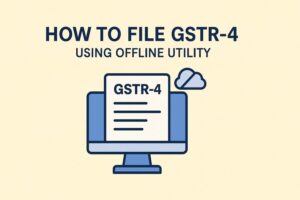What is the Penalty if GSTR 9 Wrongly filed?
- 29 Jul 25
- 9 mins

What is the Penalty if GSTR 9 Wrongly filed?
Key Takeaways
- GSTR-9 is a critical annual return that must be filed accurately to avoid penalties and audits.
- Common errors like reconciliation mismatches, ITC misreporting, and data compilation issues can lead to compliance challenges.
- Penalties for wrong filing include interest, late fees, and even prosecution in cases of fraudulent reporting.
- Technical errors and schema validation failures can delay filings and impact the taxpayer’s credibility.
- Using automation tools, staying updated on GST rules, and consulting professionals helps ensure error-free GSTR-9 filing.
Since GST was implemented, business operations have transformed drastically. They are now more transparent, compliant and accountable. Filing a GSTR 9 is an annual requirement for registered businesses. This return filing is extremely significant since it maintains the integrity of the GST system. If GSTR 9 is wrongly filed, serious repercussions might occur.
Read this blog to understand what the consequences are of wrongly filing GSTR 9.
What is GSTR-9?

GSTR 9 is an annual return filed by eligible taxpayers under the GST system. It contains a comprehensive summary of supplies, availed credit amount and tax payment details that took place within a financial year.
If GSTR 9 is wrongly filed or the taxpayer does not follow the expected structure determined by the GSTN, the GSTR-9 schema validation error takes place. The schema validation is conducted in order to check the accuracy of the provided data and its format.
The significance of accurate filing GSTR-9 is as follows:
1. Comprehensive Reporting
GSTR-9 contains a comprehensive summary of all kinds of GST transactions along with a consolidated view of different GST returns, like GSTR-1 and GSTR-3B for the whole financial year.
2. Reconciliation
The reconciliation tool helps businesses to cross-check provided data and identify if there are any kind of discrepancies.
3. Audit Trail
An audit trail is useful during tax audits, internal audits or if there are any disputes with tax authorities. Using GSTR-9, this audit trail goes on for the whole financial year.
4. Compliance
Filing GSTR-9 is a statutory obligation for businesses and failure to comply may result in legal consequences.
5. ITC Reconciliation
Using GSTR-9, businesses can reconcile their claimed ITC for that financial year. Accurate ITC claims reduce the risks of future disputes.
Types of Errors in GSTR-9 Filing

The following are some common mistakes in GSTR-9 filing:
1. Reconciliation Issues
Firstly, discrepancies within the Books of Account, GSTR-1 and GSTR-3B are common. These may arise from data entry errors, timing mismatches or vendor-related issues such as delays or omissions, leading to mismatches between claimed ITC and GSTR-2A/2B.
2. Data Compilation Challenges
While consolidating a whole year's financial data, taxpayers often struggle with having a higher transaction volume. Moreover, businesses require thorough analysis in order to categorise these transactions into smaller sections like exempt, taxable, zero-rated and nil-rated. From this whole bulk, deciding which ITC is eligible and which one is not for reversal or adjustments is time-consuming.
3. Mistakes in Last Tax Returns
While filing GSTR-9, a taxpayer has to ensure that there are no mistakes in GSTR-1, GSTR-3B or GSTR-4. Mistakes in these returns cannot be rectified once the GSTR-9 filing is complete. This might lead to wrong reporting and penalties.
4. Reversal of Input Tax Credit
An ITC reversal can emerge if a taxpayer has not paid its suppliers within 180 days. If vendor payments are not properly tracked, it might lead to ITC reversal. Taxpayers often face problems while calculating the exact reversal amount, discovering accurate reversal provisions and reporting reversal in GSTR-9.
5. ITC Reconciliation and Reverse Charge Mechanism
Aligning taxes filed under the Reverse Charge Mechanism (RCM) with ITC claims could be difficult for some taxpayers.
6. Input Tax Credit on Exempt and Blocked Supplies
While taxpayers try to avoid the input of the blocked supplies, ensuring accurate ITC calculation on exempt supplies becomes a challenge. These inaccuracies turn into compliance issues.
7. Technical Challenges and Time Constraints
Filing GSTR-9 can be challenging for businesses, especially during peak seasons. The GST portal may face technical issues, causing delays and frustration. Frequent non-compliance may attract audits, investigations or legal action.
Penalties for Wrong Filing of GSTR-9

The following are some penalties applicable if GSTR 9 is wrongly filed:
1. Penalty for Filing Fraudulent Documents
If GST authorities find that the taxpayer is filing fraudulent documents or forged records intentionally, it might be identified as tax evasion. Depending on the severity of the crime, the authorities can arrest or levy heavy fines on perpetrators under Section 132 of the CGST Act.
2. Interest on Tax Liability
If any taxpayer has underestimated the GSTR-9 tax amount, they will have to pay 18% interest on the taxable amount.
3. Penalty for Delayed Filing
Under Section 47 of the CGST Act, filing GSTR-9 after its due date attracts a late fee. The fee amount is ₹100 per day in CGST and ₹100 in SGST, so a total of ₹200 per day. However, if the fee is charged at a later date, it cannot exceed 0.25% of the total turnover amount of the taxpayer.
Impact of Errors on Taxpayers
When there are mistakes in GSTR-9, it might negatively impact business operations, tarnishing the taxpayer’s reputation. In addition, this might attract the attention of GST authorities. That will disallow ITC claims of the taxpayers, increase the tax amount and drop their confidence.
Furthermore, if this mistake in the GSTR-9 happens to repeat itself, there might be a suspension or cancellation of GST registration.
How to Avoid Penalties?

The following are some ways a taxpayer can avoid penalties if GSTR 9 is wrongly filed:
1. Stay Updated on GST Rules
GST regulations keep changing from time to time. Staying updated with these changes is crucial. A taxpayer can do this by visiting the GST portal from time to time and researching the already existing rules, rates and filing requirements.
2. Thorough Reconciliation
The figures of the GSTR-1, GSTR-2A and GSTR-3B for inward and outward supplies, have to match the figures mentioned in GSTR-9. If there are any differences in the figures, fixing them as soon as possible is necessary.
3. Verify ITC Claims
Carefully scrutinising the file, as well as ITC claims, is important. This will ensure that they are matching with the amounts spent on service movements and purchases. Furthermore, it is also important to check whether the ITC claims meet the eligibility for being lodged and are accompanied by a valid tax invoice.
4. Leverage Automation Tools
Filing GSTR-9 will be much easier if taxpayers utilise accounting software tools. These tools usually give accurate results, making compliance simple and hassle-free.
5. Use Professional Assistance
Contact a professional tax consultant or GST expert to review your return files and ask them to demarcate if they find any errors.
Benefits of Timely and Accurate Filing
Accurately filing GSTR-9 means a business has a healthy financial system and discipline. When return filing is compliant and accurate, it increases efficiency. It also eliminates penalties and interests, so the stakeholders become confident.
Conclusion
Businesses need to understand the proper way of GSTR-9 filing. That way, the businesses will be able to avoid audits and penalties imposed by the GST authorities. GST authorities provide a concrete format for GSTR-9 filing and expect businesses to abide by that.
If GSTR 9 is wrongly filed or the structure does not align with what has been provided by the GST portal, or there have been discrepancies, the taxpayer receives a scheme validation error code. Taxpayers need to resolve the issue as soon as possible to move forward.
💡If you want to streamline your invoices and make payments via credit or debit card or UPI, consider using the PICE App. Explore the PICE App today and take your business to new heights.
FAQs
What is GSTR-9 and who needs to file it?
What happens if GSTR-9 is filed incorrectly?
What are the common mistakes made during GSTR-9 filing?
What penalties apply for wrong or late filing of GSTR-9?
How can taxpayers avoid mistakes while filing GSTR-9?
Regularly reconcile GSTR-1, GSTR-3B, and books,
Validate ITC claims with proper invoices,
Stay updated on GST rule changes,
Use automation or accounting tools for accuracy, and
Seek professional advice from a GST consultant.
These steps reduce the risk of non-compliance and ensure smooth annual return filing.
 By
By 
















